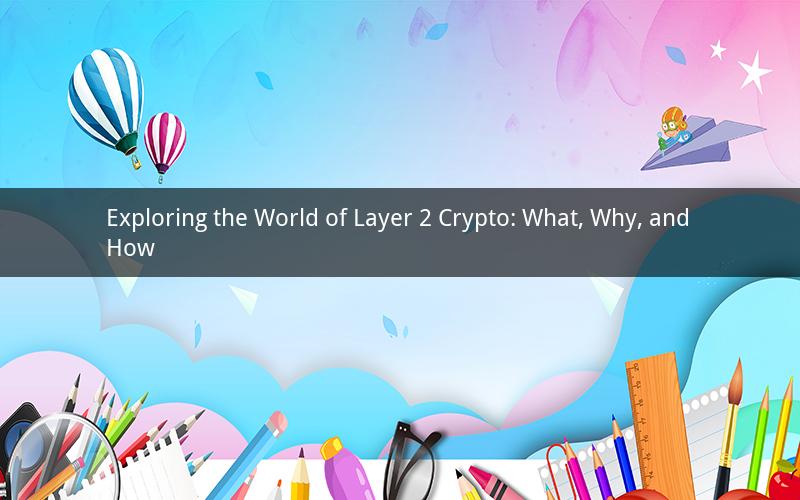
Layer 2 crypto, a term that has gained significant traction in the blockchain community, refers to a set of technologies that operate on top of existing blockchains to enhance their performance, scalability, and security. As the demand for decentralized applications continues to rise, understanding the intricacies of layer 2 crypto is essential for those looking to leverage the benefits of blockchain technology. In this article, we will delve into the concept of layer 2 crypto, its significance, and the various ways it is being implemented.
What is Layer 2 Crypto?
Layer 2 crypto is an additional layer built on top of the existing blockchain infrastructure. It aims to address some of the limitations faced by layer 1 blockchains, such as slow transaction speeds and high fees. By offloading some of the transactions to a secondary layer, layer 2 crypto enables faster and cheaper transactions while still benefiting from the security and decentralization of the underlying blockchain.
The primary goal of layer 2 crypto is to improve the user experience by reducing the time and cost associated with blockchain transactions. By achieving this, it helps in expanding the adoption of decentralized applications and blockchain technology as a whole.
Why is Layer 2 Crypto Important?
The importance of layer 2 crypto can be attributed to several factors:
1. Scalability: One of the biggest challenges faced by layer 1 blockchains is scalability. With the growing number of users and transactions, layer 1 blockchains struggle to maintain high throughput. Layer 2 crypto solves this problem by offloading transactions to a secondary layer, enabling faster processing and lower fees.
2. Cost-Effectiveness: High transaction fees have been a significant barrier for many users to adopt blockchain technology. Layer 2 crypto reduces the cost of transactions, making it more accessible for a wider audience.
3. Enhanced Security: While layer 2 solutions operate on top of the existing blockchain infrastructure, they still inherit the security features of the underlying blockchain. This means that layer 2 crypto can offer enhanced security while still maintaining the decentralization aspect.
4. Improved User Experience: By reducing transaction times and costs, layer 2 crypto contributes to a more seamless user experience. This can encourage the adoption of decentralized applications and blockchain technology.
How is Layer 2 Crypto Implemented?
There are several ways layer 2 crypto is implemented, each with its unique approach and benefits:
1. State Channels: State channels are a popular layer 2 solution that enables off-chain transactions between two parties. These transactions are recorded on the blockchain only when necessary, which results in faster and cheaper transactions. State channels are used by platforms like Lightning Network and Raiden Network.
2. Plasma: Plasma is a layer 2 solution that creates a child chain on top of the main blockchain. Transactions on the child chain are recorded on the main blockchain periodically. This enables faster transaction speeds and lower fees while maintaining the security of the main blockchain.
3. Optimistic Rollups: Optimistic rollups are another layer 2 solution that bundles multiple transactions into a single batch, which is then submitted to the main blockchain. This process reduces the number of transactions on the main blockchain, resulting in faster processing and lower fees.
4. zkRollups: zkRollups are a layer 2 solution that uses zero-knowledge proofs to verify transactions off-chain. This enables fast and secure transactions without the need for a trustless environment. zkRollups are used by platforms like Arbitrum and Optimism.
5. Validium: Validium is a layer 2 solution that uses a hybrid model, combining aspects of both optimistic and zkRollups. This approach aims to provide a balance between scalability and security.
FAQs:
1. Q: Can layer 2 crypto improve the scalability of Ethereum?
A: Yes, layer 2 crypto can significantly improve the scalability of Ethereum by offloading transactions to a secondary layer, reducing the load on the main Ethereum network.
2. Q: Are layer 2 solutions more secure than layer 1 blockchains?
A: Layer 2 solutions inherit the security features of the underlying blockchain, but they are still subject to their own vulnerabilities. While layer 2 crypto aims to enhance security, it is crucial to evaluate each solution's security mechanisms.
3. Q: Can layer 2 crypto be used with any blockchain?
A: Yes, layer 2 crypto can be implemented on various blockchains, but the compatibility may vary depending on the specific technology and architecture of the blockchain.
4. Q: Are there any limitations to layer 2 crypto?
A: While layer 2 crypto offers several benefits, it also has limitations. One of the main challenges is interoperability, as different layer 2 solutions may not be compatible with each other.
5. Q: What is the future of layer 2 crypto?
A: The future of layer 2 crypto looks promising, as it continues to evolve and improve. With ongoing research and development, we can expect more advanced and secure layer 2 solutions to emerge, further enhancing the scalability, cost-effectiveness, and user experience of blockchain technology.